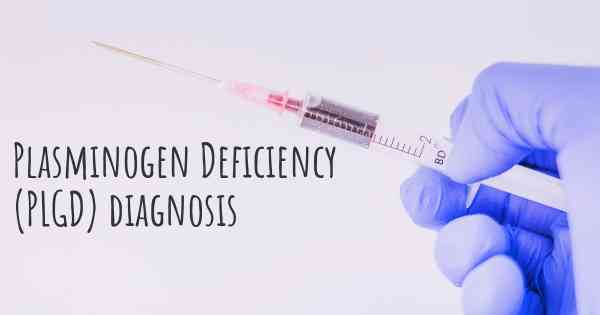4
How is Plasminogen Deficiency (PLGD) diagnosed?
See how Plasminogen Deficiency (PLGD) is diagnosed. Which specialists are essential to meet, what tests are needed and other useful information for the diagnosis of Plasminogen Deficiency (PLGD)

Laboratory Tests for Plasminogen (PLG)
Your doctor may order tests that evaluate the PLG antigen and activity level in the body. This blood testing analysis (assays) will help determine if PLG activity and levels are both diminished, which would indicate congenital PLGD. In mild cases of PLGD, PLG levels may be close to normal; however, the activity is decreased.
Diagnostic Procedures
Your doctor may also send a surgically removed lesion (biopsy) to the lab to determine if the biopsy demonstrates a buildup of fibrin-rich deposits when viewed under a microscope.
Genetic Testing
Genetic testing is used to confirm or rule out suspected PLGD. The condition is caused by mutations in a gene that provide instructions to the body for making the protein called plasminogen. Parents each carry one copy of the mutated gene, but typically do not show any signs and symptoms of the condition.
Specialists
- Hematologist: A doctor who specializes in treating blood conditions
- Ophthalmologist: A doctor who specializes in treating certain vision problems and eye diseases
- Pediatrician: A doctor who specializes in caring for the overall health of children and treating childhood illnesses
- Dental specialist: A doctor who specializes in treating problems of the teeth and gums
- Pulmonologist: A doctor who specializes in treating lung conditions and diseases
- Nephrologist: A doctor who specializes in the care and treatment of kidney diseases
- Neurologist: A doctor who specializes in treating disorders that affect the brain, spinal cord, and nerves
Your doctor may order tests that evaluate the PLG antigen and activity level in the body. This blood testing analysis (assays) will help determine if PLG activity and levels are both diminished, which would indicate congenital PLGD. In mild cases of PLGD, PLG levels may be close to normal; however, the activity is decreased.
Diagnostic Procedures
Your doctor may also send a surgically removed lesion (biopsy) to the lab to determine if the biopsy demonstrates a buildup of fibrin-rich deposits when viewed under a microscope.
Genetic Testing
Genetic testing is used to confirm or rule out suspected PLGD. The condition is caused by mutations in a gene that provide instructions to the body for making the protein called plasminogen. Parents each carry one copy of the mutated gene, but typically do not show any signs and symptoms of the condition.
Specialists
- Hematologist: A doctor who specializes in treating blood conditions
- Ophthalmologist: A doctor who specializes in treating certain vision problems and eye diseases
- Pediatrician: A doctor who specializes in caring for the overall health of children and treating childhood illnesses
- Dental specialist: A doctor who specializes in treating problems of the teeth and gums
- Pulmonologist: A doctor who specializes in treating lung conditions and diseases
- Nephrologist: A doctor who specializes in the care and treatment of kidney diseases
- Neurologist: A doctor who specializes in treating disorders that affect the brain, spinal cord, and nerves
Posted Aug 9, 2017 by jodoinjulie 2000








